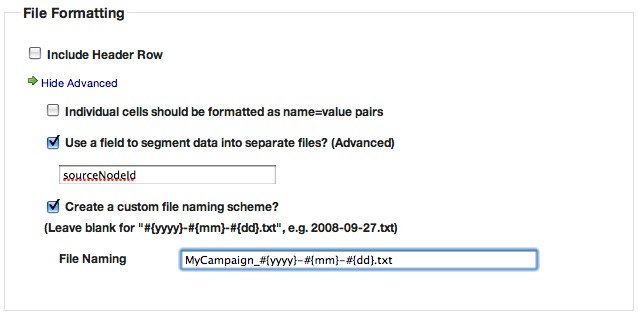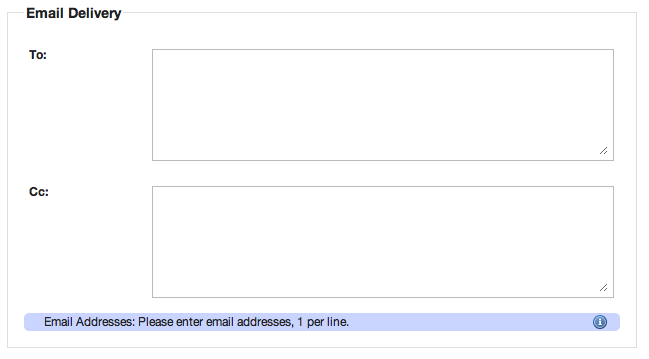Introduction
This document is constantly under revision and there may be many pieces to the puzzle yet missing. If you have any questions about specific features, comments or concerns please contact support@activeprospect.com.
Dashboard
Scheduled Deliveries
Add/Edit
A scheduled delivery is comprised of a number of aspects: the destination, the format, the transport and the schedule. Each part represents a specific component required to fulfill the lifecycle of a delivery.
Destination

Formatting

Scheduling

Transport (FTP/SFTP)

The FTP/SFTP Transport mechanisms allow you to set a target server as your delivery end point. You will need at least the hostname to fulfill all required elements here. You must also add the username and password unless you have either 1) set a blanket allow for the delivery adapter servers to upload files to your server (contact support) or 2) you've set up the appropriate password-less entries per the given public key file which can be obtained within the app. You can also provide a differing port (in case you are not using the default ports per protocol) and provide a remote path of your choosing. The remote path should be a folder relative to the root once logged in. So, for example, if you log into a server and there is a "test" folder where you want to receive your files then you would add "test/" - the trailing slash here is very important as that lets us know it is a folder/directory relative to the one we arrive at once logged in.
Transport (E-mail)
The email transport system for outbound deliveries works much the same way as regular e-mail. You can set individual To: and Cc: Addresses as you wish. This facilitates the possibility of sending out emails that can easily be set as Reply-All if needed. Additionally, you will see all individuals who will receive a copy of the data.
Viewing

Overview
The scheduled delivery overview provides a succinct review of information regarding your delivery.
- Pending Records - Shows how many pending records you have that will be sent out in the next delivery.
- Deliver Now - Allows you to execute a delivery right away, without waiting for the next scheduled time. Deliveries will continue to function as normal, delivering normally at the next scheduled time.
- Delivery Name - The name assigned to the delivery. Meant mostly for your record keeping purposes.
- Total Records - The sum of total records that have or will be delivered for this delivery.
- Capture Inbound Data - This option allows you to determine whether or not you would like to receive data from your sources. If you set up multiple sources with the provided posting url and either the campaign/project has expired or you have determined you no longer want to run this destination you can easily stop receiving data by disabling inbound records. If unchecked, the system will return an HTTP status code of 404 to the source user. Additionally, the given data will not be recorded.
- Run Outbound Deliveries - This options allows you to control the outbound delivery mechanism. If the scheduled delivery has been activated and you need to be able to stop or pause that delivery for a specific period of time then you can manually uncheck this option and the outbound deliveries will not run until you re-enable them. No other mechanism can change this state and it ignores all given scheduling. You will continue to receive inbound data unless you have turned off that function separately.
- Deactivate this delivery - Effectively turns off receiving of inbound data and running of outbound deliveries and sets the delivery in a deactivated state. This cannot be undone.
- Posting URL - This is the URL that you will use to post data to from your sources or source forms.
- Schedule - The schedule by which the outbound deliveries are run.
- Transport - The mechanism by which the outbound deliveries are sent.
- Formatting - The information that shows how the file should be formatted before sent on to its destination. This includes file format, name, and segmentation (if needed).
- Quick view - shows if the current delivery is activated and if it is scheduled to send outbound deliveries.
Shipments
Shipments provide information on previously delivered items.



 Title Index
Title Index
 Recently Changed
Recently Changed
 Page Hierarchy
Page Hierarchy
 Incomplete
Incomplete
 Tags
Tags


